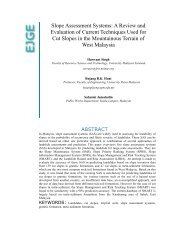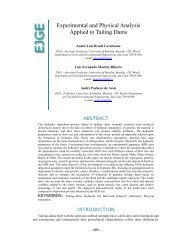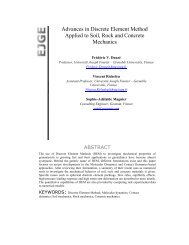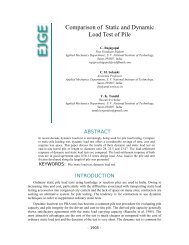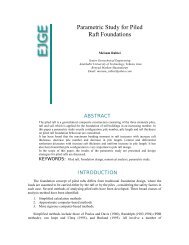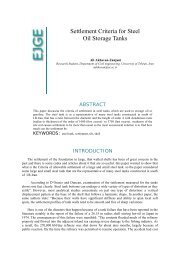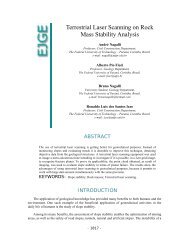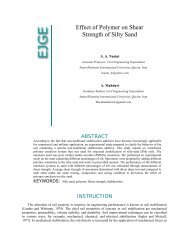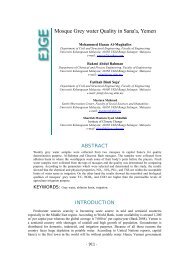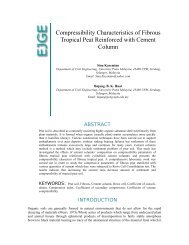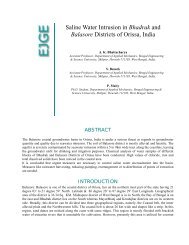Study of Passive Isolation of Deep Foundations in Sandy ... - Ejge.com
Study of Passive Isolation of Deep Foundations in Sandy ... - Ejge.com
Study of Passive Isolation of Deep Foundations in Sandy ... - Ejge.com
You also want an ePaper? Increase the reach of your titles
YUMPU automatically turns print PDFs into web optimized ePapers that Google loves.
Vol. 16 [2011], Bund. Q 1302<br />
Hm<br />
Bf<br />
Lm<br />
Figure 2: Problem def<strong>in</strong>ition <strong>of</strong> passive isolation by open trench<br />
GEOMETRIC MODEL<br />
In order to reduce the <strong>com</strong>putation time and <strong>in</strong> accordance with the axisymmetric ½ <strong>of</strong> the actual model is<br />
built <strong>in</strong> two-dimensional model. To prevent any wave reflection from the base <strong>of</strong> model, the depth <strong>of</strong> model is<br />
not less than 30m (Jesmani 2008).<br />
FINITE ELEMENT MODEL STRATEGIES<br />
The properties which affect the wave propagation <strong>in</strong> low stra<strong>in</strong> are Stiffness, Damp<strong>in</strong>g, Poisson, Ratio and<br />
Density. Stiffness and damp<strong>in</strong>g are more important and effective than other properties because the predicted<br />
stra<strong>in</strong>s are lower than 10 -3 ; therefore, l<strong>in</strong>ear elastic is applied to simulate the soil behavior and the above<br />
parameters are <strong>in</strong>volved (Figure 3) ( Ishihara. K, 1996).<br />
In two-dimensional model the <strong>com</strong>putation is done under the assumption <strong>of</strong> pla<strong>in</strong> stra<strong>in</strong> condition. To<br />
simulate the behavior <strong>of</strong> soil <strong>in</strong> places which we have stress concentration and we need exact stra<strong>in</strong>s, two<br />
dimensional PLANE82, In places which the stra<strong>in</strong>s and stresses gradient don’t play an important role <strong>in</strong> results,<br />
two-dimensional PLANE42, and for simulat<strong>in</strong>g the behavior <strong>of</strong> concrete foundation, two-dimensional plane82<br />
have been employed.<br />
To evaluate the behavior <strong>of</strong> soil and the foundation such as slid<strong>in</strong>g or any probable separation at the soil<br />
structure <strong>in</strong>terface, two-dimensional surface-to-surface contact elements (TARGE169, CONTA171) have been<br />
employed. Because <strong>of</strong> the rigidity <strong>of</strong> the foundation <strong>com</strong>pared with the underly<strong>in</strong>g soil, the soil surface and pile<br />
are taken as contact surface and target surface. Normal contact stiffness and maximum contact friction<br />
coefficient are presumed to be equal to 1 and 0.6 respectively. PLANE42 is def<strong>in</strong>ed by four nodes hav<strong>in</strong>g two<br />
degrees <strong>of</strong> freedom at each node and PLANE82 is the developed form <strong>of</strong> PLANE42 with eight<br />
nodes(figure4)and all <strong>of</strong> them have plasticity, creep, swell<strong>in</strong>g, stress stiffen<strong>in</strong>g, large deflection and large stra<strong>in</strong><br />
capabilities (ANSYS Manual).



